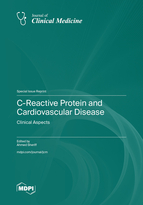C-Reactive Protein and Cardiovascular Disease: Clinical Aspects
A special issue of Journal of Clinical Medicine (ISSN 2077-0383). This special issue belongs to the section "Cardiovascular Medicine".
Deadline for manuscript submissions: closed (15 February 2022) | Viewed by 30010
Special Issue Editor
2. Pentracor GmbH, 16761 Hennigsdorf, Germany
Interests: acute myocardial infarction; acute-phase proteins; apheresis; complement system; COVID-19; C-reactive protein; inflammation; innate immune system; organ damage; stroke
Special Issues, Collections and Topics in MDPI journals
Special Issue Information
Dear Colleagues,
C-reactive protein (CRP) is widely established as significant prognostic biomarker in cardiovascular disease (CVD). It has recently been recognized as mediator and driver of inflammatory processes during atherosclerosis and CVD, promoting the deterioration of tissue and organ damage. Still, CRP is not normally evaluated as part of the standard clinical procedure to obtain a certain prognosis of the clinical outcome. It is also widely ignored as a therapeutic target in anti-inflammatory therapies for treating CVD. Hence, CRP is a strongly undervalued molecule and only using it as biomarker for inflammation does not do its function justice. Therefore, there is a great need to shed a different light on the role of CRP in CVD and interpret clinical data not only in regard to CRP as biomarker but while keeping in mind that CRP itself functions as driver of tissue damage.
The present Special Issue aims to provide an overview of relevant studies and provide an outlook into the future perspective on this pivotal protein. This will not only provide valuable information on the potential for CRP-driven prognostic decisions in CVD patients but also identify obstacles that need to be overcome to address CRP therapeutically.
Dr. Ahmed Sheriff
Guest Editor
Manuscript Submission Information
Manuscripts should be submitted online at www.mdpi.com by registering and logging in to this website. Once you are registered, click here to go to the submission form. Manuscripts can be submitted until the deadline. All submissions that pass pre-check are peer-reviewed. Accepted papers will be published continuously in the journal (as soon as accepted) and will be listed together on the special issue website. Research articles, review articles as well as short communications are invited. For planned papers, a title and short abstract (about 100 words) can be sent to the Editorial Office for announcement on this website.
Submitted manuscripts should not have been published previously, nor be under consideration for publication elsewhere (except conference proceedings papers). All manuscripts are thoroughly refereed through a single-blind peer-review process. A guide for authors and other relevant information for submission of manuscripts is available on the Instructions for Authors page. Journal of Clinical Medicine is an international peer-reviewed open access semimonthly journal published by MDPI.
Please visit the Instructions for Authors page before submitting a manuscript. The Article Processing Charge (APC) for publication in this open access journal is 2600 CHF (Swiss Francs). Submitted papers should be well formatted and use good English. Authors may use MDPI's English editing service prior to publication or during author revisions.
Keywords
- biomarkers
- cardiovascular medicine
- coronary artery disease
- cytokines and chemokines
- inflammation
- immunotherapy
- myocardial infarction
- tissue repair







